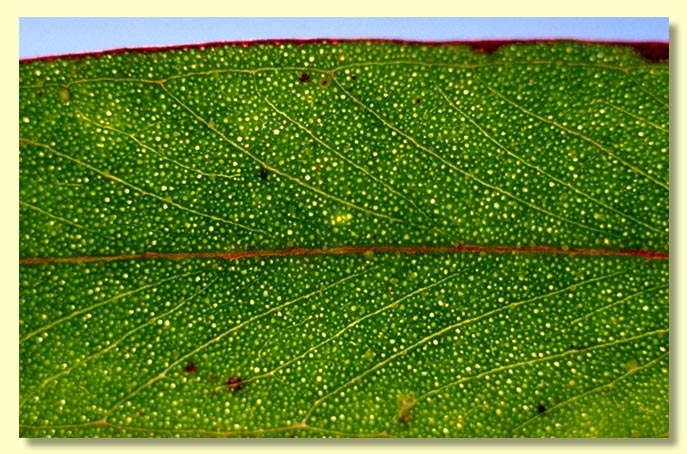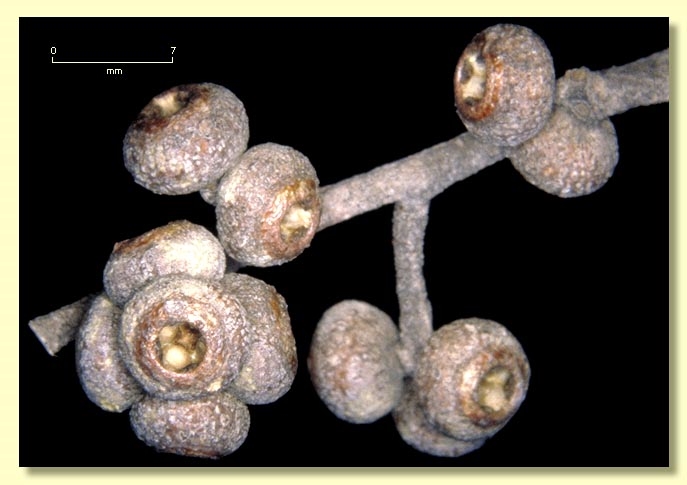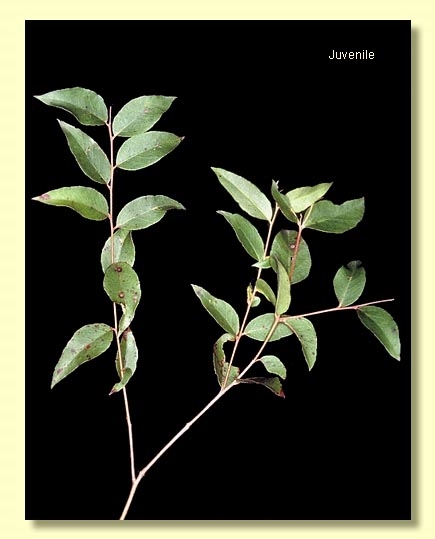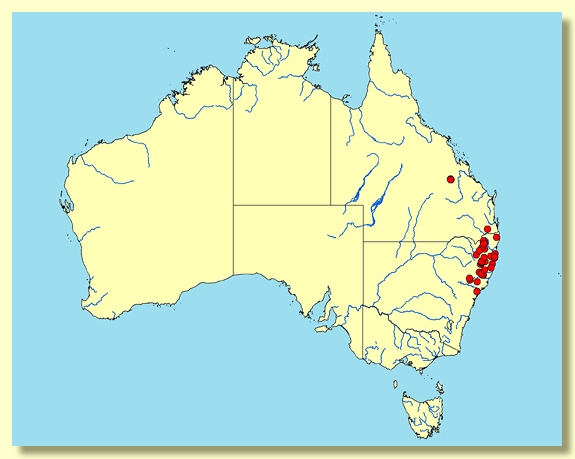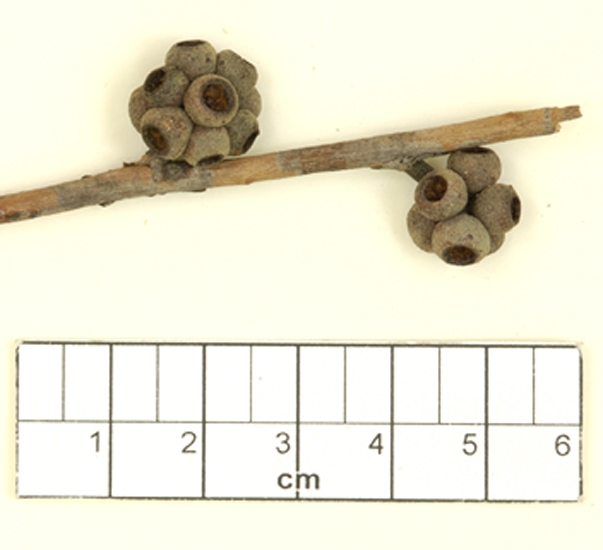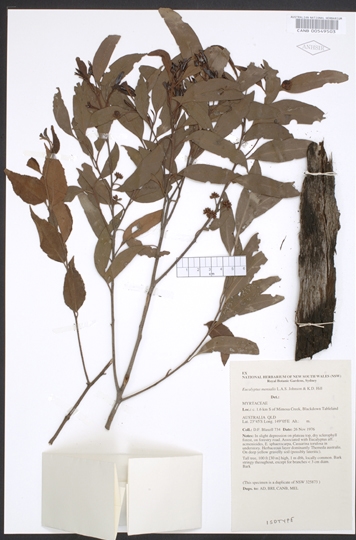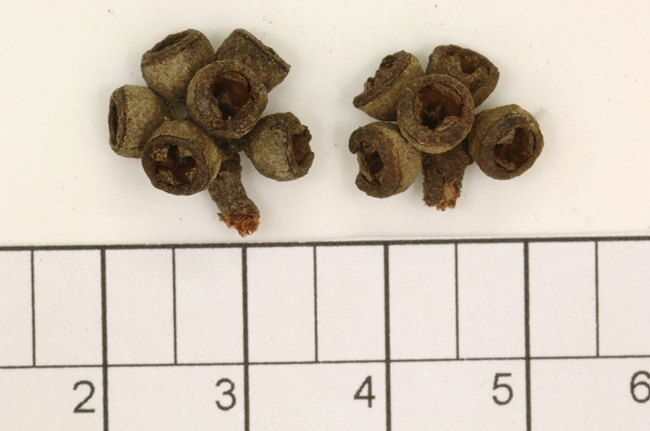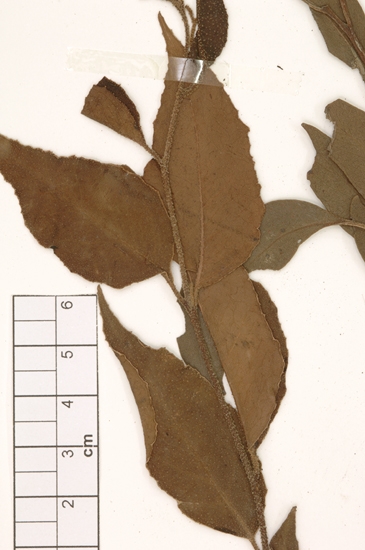Euclid - Online edition
Eucalyptus cameronii
Eucalyptus | Eucalyptus | Capillulus | Pachyphloius
Bark rough and stringy to the small branches, grey or brown-grey.
Juvenile growth (coppice or field seedlings to 50 cm): stem rounded in cross-section, growing tips and stems scabrid to node 16 at least; juvenile leaves always petiolate, opposite until nodes 6–10 then becoming alternate, elliptical then lanceolate to ovate, 2.5–7 cm long, 0.9–4 cm wide, discolorous, glossy, green, scabrid on petioles, midrib and margin only.
Adult leaves alternate, petiole 0.6–1.6 cm long; blade lanceolate to falcate, (4)5.5–13 cm long, 0.8–2.6 cm wide, base usually quite oblique, slightly discolorous or concolorous, glossy, green, side-veins usually acute, sparsely to moderately reticulate, intramarginal vein parallel to and well removed from margin, oil glands island.
Inflorescence axillary unbranched, peduncles 0.5–1.2 cm long, buds in umbels of 9 to 15, sessile or shortly pedicellate (pedicels to 0.2 cm). Mature buds fusiform to obovoid, 0.4–0.5 cm long, 0.3 cm wide, scar absent, operculum rounded to conical, stamens irregularly flexed, anthers reniform to cordate, versatile, dorsifixed, dehiscing by confluent slits, style long, stigma tapered, locules 3 or 4, the placentae each with 2 vertical ovule rows. Flowers white.
Fruit sessile to shortly pedicellate (pedicels to 0.2 cm long), cup-shaped, truncate-globose or hemispherical, 0.4–0.5 cm long, 0.4–0.6(0.8) cm wide, disc raised-convex or -annular, or disc level to slightly descending, valves 3 or 4, enclosed to slightly exserted.
Seeds brown, 1–2.3 mm long, pyramidal or obliquely pyramidal, dorsal surface smooth, hilum terminal.
Cultivated seedlings (measured at ca node 10): cotyledons reniform; stems rounded in cross-section, stellate-hairy; leaves always petiolate, opposite until node 5 to 10 then alternate, ovate-lanceolate, 3.5–8.5 cm long, 1.5–5 cm wide, base rounded to truncate or sometimes slightly lobed, margin irregular (crinkled), apex pointed, discolorous, darker green and glossy above, paler beneath. Stems and leaves scabrid with stellate hairs to at least node 15, but leaves only ever hairy on margins, petiole and midrib underneath.
Flowering has been recorded in March.
A small to medium-sized stringybark tree of the eastern side of the Northern Tablelands of New South Wales, extending just across the Queensland border to near the summit of Mt Fraser north-west of Aratula, with a disjunct occurrence further north on the Blackdown Tableland. It occurs in wet sclerophyll forests near the escarpment of the tablelands and adjacent coastal ranges, on ridges with reasonable soil development and on deeper, richer soils on lower valley slopes. Eucalyptus cameronii has rough fibrous bark to the small branches, a green crown, more or less sessile buds and fruit, with the fruit crowded tpgether but not laterally compressed, and scabrid, ovate juvenile leaves or shortish petioles. It closely resembles E. globoidea of coastal central and southern New South Wales and eastern Victoria, but E. cameronii has smaller buds and fruit and juvenile leaves only sparsely hairy.
Within its natural range there are several other stringybark species that might be confused with E. cameronii. E. laevopinea has shallowly furrowed rough bark and smooth-barked outer branches, more ovoid buds on longer pedicels and fruit 0.8–1.4 cm wide. E. caliginosa has larger usually pedicellate fruit 0.6–0.8 cm wide. E. youmanii has slightly angled buds and larger fruit, 0.7–1.3 cm wide. E. williamsiana has coarser juvenile and adult leaves and fruit usually completely sessile and 1.1–1.5 cm diameter. E. mckieana has smaller more flat-topped fruit 0.5–0.6 cm diameter and narrower juvenile leaves.
The ash species E. andrewsii (with two subspecies) occurs in this general area also and has furrowed fibrous bark but differs in the smaller cupular to campanulate fruit and strongly petiolate bluish green pendulous juvenile leaves that are never scabrid.
On the Blackdown Tableland there are several fully rough, fibrous "stringy" barked eucalypt species that may be superficially confused with E. cameronii. E. sphaerocarpa has a bluish crown, sub-spherical fruit 1–1.3 cm diameter and with enclosed valves, and glabrous juvenile leaves; E. baileyana which in flower has stamens arranged in discrete bundles, squat urceolate fruit 1–1.7 cm diameter and with descending disc, and juvenile leaves densely stellate hairy; and two white mahogany species, E. acmenoides with conspicuously discolorous adult leaves and E. mediocris with concolorous leaves, both having densely reticulate venation in the adult leaves (always sparsely reticulate in all true stringybarks), and glabrous juvenile leaves opposite for many pairs.
The authors of EUCLID regard the Blackdown Tableland endemic E. mensalis as morphologically indistinguishable from E. cameronii and therefore place the former in synonymy.
MORE ABOUT STRINGYBARKS



